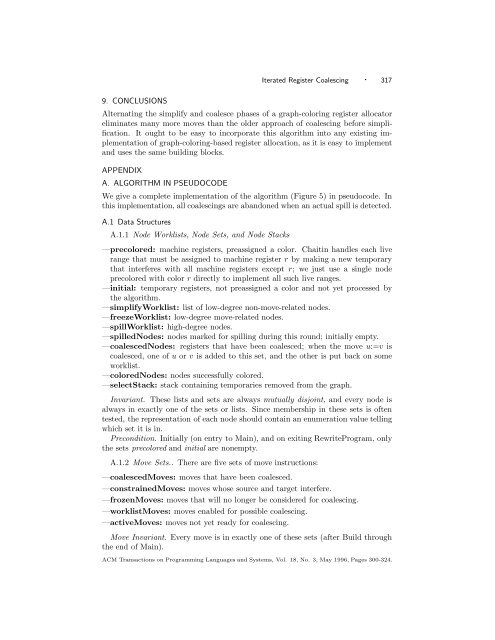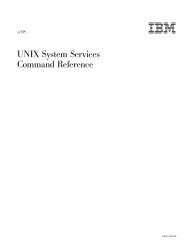Iterated Register Coalescing - School of Computer Science
Iterated Register Coalescing - School of Computer Science
Iterated Register Coalescing - School of Computer Science
Create successful ePaper yourself
Turn your PDF publications into a flip-book with our unique Google optimized e-Paper software.
<strong>Iterated</strong> <strong>Register</strong> <strong>Coalescing</strong> · 3179. CONCLUSIONSAlternating the simplify and coalesce phases <strong>of</strong> a graph-coloring register allocatoreliminates many more moves than the older approach <strong>of</strong> coalescing before simplification.It ought to be easy to incorporate this algorithm into any existing implementation<strong>of</strong> graph-coloring-based register allocation, as it is easy to implementand uses the same building blocks.APPENDIXA. ALGORITHM IN PSEUDOCODEWe give a complete implementation <strong>of</strong> the algorithm (Figure 5) in pseudocode. Inthis implementation, all coalescings are abandoned when an actual spill is detected.A.1 Data StructuresA.1.1 Node Worklists, Node Sets, and Node Stacks—precolored: machine registers, preassigned a color. Chaitin handles each liverange that must be assigned to machine register r by making a new temporarythat interferes with all machine registers except r; wejustuseasinglenodeprecolored with color r directly to implement all such live ranges.—initial: temporary registers, not preassigned a color and not yet processed bythe algorithm.—simplifyWorklist: list <strong>of</strong> low-degree non-move-related nodes.—freezeWorklist: low-degree move-related nodes.—spillWorklist: high-degree nodes.—spilledNodes: nodes marked for spilling during this round; initially empty.—coalescedNodes: registers that have been coalesced; when the move u:=v iscoalesced, one <strong>of</strong> u or v is added to this set, and the other is put back on someworklist.—coloredNodes: nodes successfully colored.—selectStack: stack containing temporaries removed from the graph.Invariant. These lists and sets are always mutually disjoint, and every node isalways in exactly one <strong>of</strong> the sets or lists. Since membership in these sets is <strong>of</strong>tentested, the representation <strong>of</strong> each node should contain an enumeration value tellingwhich set it is in.Precondition. Initially (on entry to Main), and on exiting RewriteProgram, onlythe sets precolored and initial are nonempty.A.1.2 Move Sets.. There are five sets <strong>of</strong> move instructions:—coalescedMoves: moves that have been coalesced.—constrainedMoves: moves whose source and target interfere.—frozenMoves: moves that will no longer be considered for coalescing.—worklistMoves: moves enabled for possible coalescing.—activeMoves: moves not yet ready for coalescing.Move Invariant. Every move is in exactly one <strong>of</strong> these sets (after Build throughthe end <strong>of</strong> Main).ACM Transactions on Programming Languages and Systems, Vol. 18, No. 3, May 1996, Pages 300-324.









